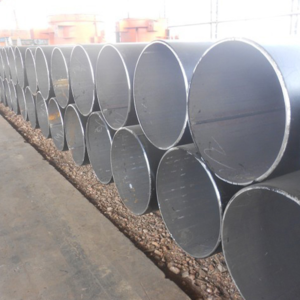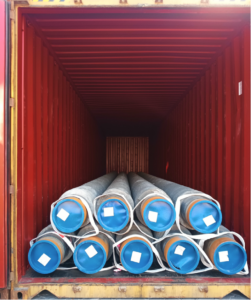Welded steel pipe and seamless steel pipe are two of the most commonly used types of steel pipes in the industry. Both are made from steel, but there are significant differences between the two that affect their performance, reliability, and overall quality. In this article, we will take a closer look at the differences between welded steel pipes and seamless steel pipes, including their manufacturing process, design, structure, and other important factors.

Manufacturing Process
The first and most significant difference between welded steel pipes and seamless steel pipes is their manufacturing process. Welded steel pipes are manufactured by taking a strip of steel and rolling it into a cylinder. The edges of the strip are then welded together using an electric current or a high-frequency welding process. The welding process creates a strong, reliable seam that holds the pipe together and prevents leaks.
Seamless steel pipes, on the other hand, are manufactured using a different process. They are created by piercing a round steel bar and then stretching it into a tube shape. The process of piercing and stretching ensures that the final product has no seams or joints, which makes it ideal for use in high-pressure and high-temperature applications.

Design and Structure
Another key difference between welded steel pipes and seamless steel pipes is their design and structure. Welded steel pipes have a seam along the length of the pipe, which is visible and can be felt. This seam can weaken the pipe and make it more susceptible to leaks and other types of damage.
Seamless steel pipes, on the other hand, have a smooth surface and a uniform structure. They have no seams or joints, which makes them stronger and more durable than welded steel pipes. Seamless steel pipes are also less likely to leak and are more resistant to corrosion and other types of damage.
Strength and Durability
The strength and durability of welded steel pipes and seamless steel pipes are two of the most important factors to consider when selecting a steel pipe. Welded steel pipes are typically weaker and less durable than seamless steel pipes. The seam along the length of the pipe can weaken the structure and make it more susceptible to leaks and other types of damage.
Seamless steel pipes, on the other hand, are much stronger and more durable. The lack of seams and joints makes them more resistant to leaks and other types of damage. They are also less likely to fail under high pressure and high temperatures, which makes them ideal for use in a wide range of applications, including high-pressure pipelines, boilers, and other types of high-temperature systems.
Cost
Cost is another important factor to consider when selecting a steel pipe. Welded steel pipes are typically less expensive than seamless steel pipes, due to the simpler manufacturing process. However, the lower cost of welded steel pipes can come at a cost in terms of strength and durability.
Seamless steel pipes are more expensive, but they offer higher quality and performance. The investment in a seamless steel pipe is often worth it, given the increased strength and durability of the final product.
In conclusion, welded steel pipes and seamless steel pipes are both commonly used types of steel pipes. However, there are significant differences between the two, including their manufacturing process, design, structure, strength and durability, and cost. Understanding these differences is important when selecting the right type of steel pipe for your application. Ultimately, the best choice depends on your specific needs, requirements, and budget.
For both seamless steel pipe and welded steel pipe, Xinyue Steel Group is always your best choice for steel pipe supplier!

